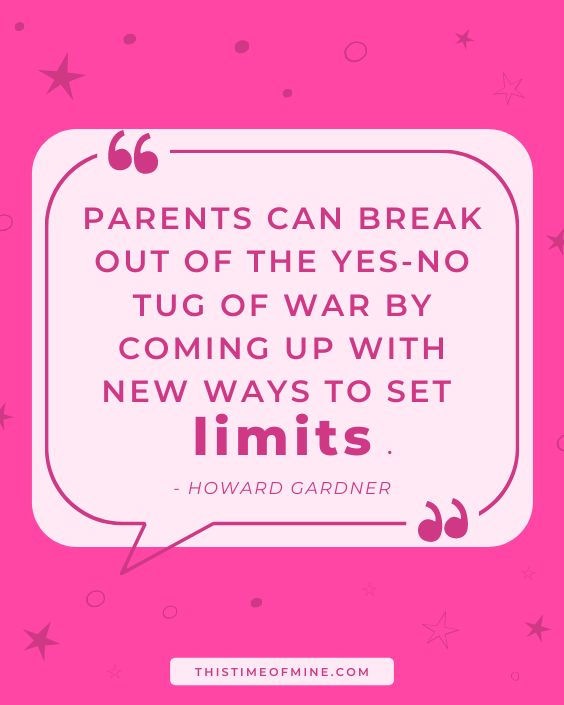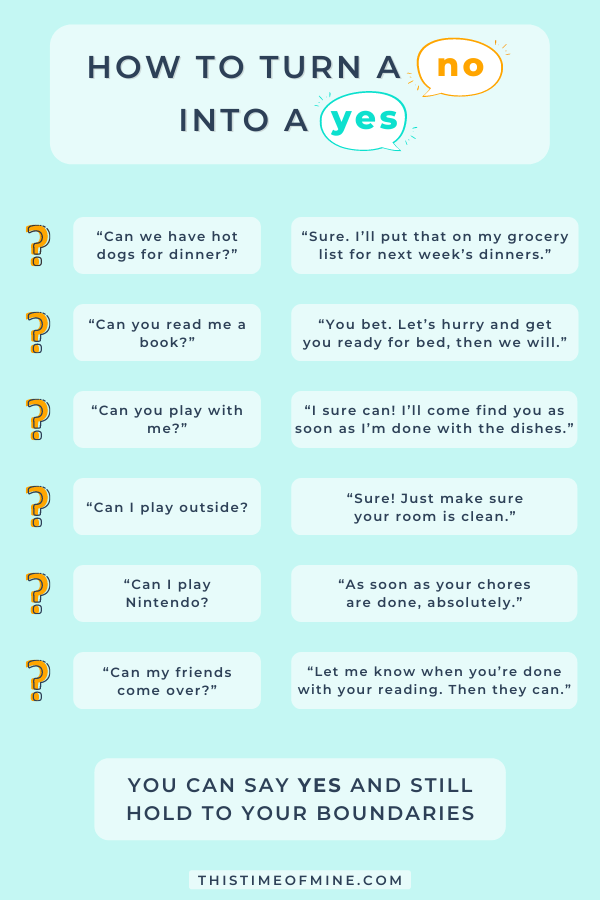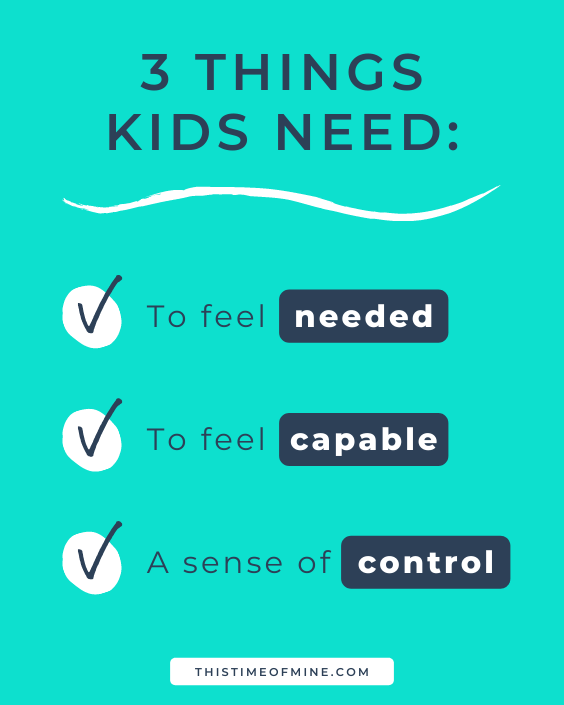How To Turn A NO Into A YES! (And Still Set Clear Boundaries For Your Kids)
Sick of being the parent who says “no” all the time? Learn how to get clear about the boundaries you set so your kids can hear “yes” a lot more!

How many times does a child hear the word “no” in a day?
On average, a whole lot more that we realize. They test our boundaries, we say no, and around and around it goes.
But what if there was a way to work within that cycle that empowered your kids to set their own limits? A way to hold to your boundaries while allowing your kids a little more wiggle room?
Trust me when I say – it’s a relief to cast off the label as the “no parent.”
I used to say “no” so many times, I didn’t even realize I was saying it anymore. It became a natural reaction to almost anything my kids wanted to do.
I justified it by telling myself I was keeping my kids safe and healthy, or teaching them obedience – or that I was just tired of making so many decisions. But what I didn’t realize was that I was making things harder than they needed to be.
The more my kids came to expect my “no”, the more creative they got. And truthfully, it started to wear me down.
So I tried a little experiment. And what I found was that I could still set clear boundaries AND have my kids willingly stay within them.
It was all in the phrasing.
GETTING CLEAR ABOUT THE BOUNDARIES YOU SET FOR YOUR KIDS
Have you ever tried enforcing a boundary only to be met with fierce resistance?
Kids have a way of making us feel insecure about limit-setting. They leave us questioning if we’re being too harsh, too permissive, or too strict.
But the truth is – our kids need us to set clear, consistent, and firm boundaries! When they know what to expect, they feel safe and secure.
But kids also need a little wiggle room. They need opportunities to practice making positive decisions that will bring them the results they desire.
So how can you facilitate this type of learning? By getting a little more creative in your approach.
Howard Gardner, author of Changing Minds, puts it this way:

And that’s exactly what we’re going to cover in this post. Here’s a quick rundown of what you’ll find:
- Benefits Of Saying “Yes” To Your Kids
- How To Reframe Your “No”
- Helping Kids WANT To Stay Within The Boundaries You Set
- 5 Common Questions About Setting Boundaries
- 1. What Should I Do If My Kids Ignore The Boundary?
- 2. How Do I Deal With Whining, Tantrums, And Other Outbursts?
- 3. My Child Is Happy – Until It’s Time To Enforce The Boundary. What Should I Do?
- 4. How Should I Respond When Other Adults Tell Me I’m Being Too Soft?
- 5. What If The Answer Is Still “No”?
Alright, let’s dive in.
This post contains affiliate links. For more information, see my disclosures here.

BENEFITS OF SAYING “YES” TO YOUR KIDS
Many parents struggle with saying “yes.” Maybe they’re afraid of spoiling or over-indulging their child. Or maybe they’re worried about relinquishing control as a parent.
Or perhaps, they are simply exhausted from the countless petitions they receive from their kids every single day and find it easier to answer everything with a universal “no.”
But here’s the thing: as our kids grow, so does their need for autonomy. Of course, it’s a gradual transfer of power over the course of their childhood. But allowing that change helps them grow in confidence and develop the ability to make good choices throughout their lives.
Saying yes more often can also:
- Strengthen the parent-child relationship
- Allow for more frequent positive interactions
- Transform negative reactions (whining, tantrums, backtalk, etc.)
- Help children become more open-minded
- Increase optimism
- Encourage children to be more productive
- Develop resilience
- Build trust between parents and children
- Help children accept a true “no”
- Give children the confidence to try new things
I’ll be the first to admit that saying “no” is easier. It takes effort to give our kids a fair hearing and take each request into account. But doing so just might be the very thing that brings more positivity and obedience into your home.
HOW TO REFRAME YOUR “NO”
Positive parenting sounds great in theory. But in the heat of the moment, it can be hard to respond gently or quickly enough to stick to the positive goals you set.
That’s why having a script is such a powerful tool. Having an idea of what to say beforehand can save you from being caught off-guard so you can respond intentionally.
But before we jump into some of those positive phrases, it’s important to know the general rule for turning a “no” into a “yes.” Knowing this rule will help you adapt the following examples to any situation:
The best way to stick to the boundaries you set while still allowing for a clear “yes” is to add a condition that casts the “yes” into the future.

Here are some examples to show you what I mean:
- “Can I play outside?”
- “Sure! Just make sure your room is clean.”
- “Can I have a snack?”
- “You bet. As soon as you wash your hands.”
- “Can I watch a show?”
- “As soon as your chores are done, absolutely.”
- “Can I FaceTime my friend?”
- “No problem. Just make sure your homework is done first.”
- “Can my friends come over?”
- “Let me know when you’re done with your reading. Then they can.”
- “Can we get ice cream?”
- “As long as your chores are done, we’ll make sure to do that this weekend.”
- “Can I build a fort?”
- “No problem. Just be sure to clean up your toys first to make room.”
- “Can we have hot dogs for dinner?”
- “Sure. I’ll put that on my grocery list for next week’s dinners.”
- “Can you read me a book?”
- “You bet. Let’s hurry and get you ready for bed, then we will.”
- “Can you play with me?”
- “I sure can! I’ll come find you as soon as I’m done with the dishes.”

In truth, you might not always get an enthusiastic “ok” in response, and you might even hear grumbles about how you’re so conditional. (We’ll go over how to handle that in a minute.) But the more your kids come to expect your positive consistency, the better they’ll get at responding to it.
It WILL start to pay off.
HELPING KIDS WANT TO STAY WITHIN THE BOUNDARIES YOU SET
While there’s no secret formula that will get your kids to cooperate happily every single time, there is something that will increase the chances of success – a basic understanding that every child needs 3 things:

1. KIDS NEED TO FEEL NEEDED
Believe it or not, kids want to obey. They want to please their parents and feel connected to them.
Of course, that doesn’t make them naturally obedient all of the time. But when we make a clear effort in our relationships, our kids are usually more willing to stick to the boundaries we set.
That doesn’t mean our relationships are perfect, it just means that we keep doing the little things that help our kids feel loved.
2. KIDS NEED TO FEEL CAPABLE
Parents can help their kids follow through by making it easier for them to do what they ask. There are a few ways to do this:
- Display checklists, visual reminders, and routine charts to help kids remember what to do.
- Create an environment where things are easy to reach so kids can do things independently.
- Make your expectations clear and be sure they know how to do what you ask.
- Set timers to help kids with time management.
- Keep your requests (and time tables) reasonable. Kids do better with bite-sized instructions and usually need more time than we think.
- Brainstorm ways to make completing tasks more fun. Always rely on your child’s desire to have fun.
The easier we make it for our kids to obey, the more they can do on their own. And that just might be the key to less grumbling!
3. KIDS NEED A SENSE OF CONTROL
When it comes to enforcing limits, the ultimate goal isn’t to control the little people in our lives. It’s to help our kids grow into capable adults that know how to set their own clear boundaries. And when we allow our kids to feel a sense of autonomy over their choices, they can begin learning this important life skill.
How can we do this?
By giving them the chance to practice making decisions within the safety net of our guidance.
In the positive phrasing examples above, notice how each response puts the responsibility on the child. In order to reach the desired outcome, the child – not the parent – gets to choose what actions come next.
4. KIDS NEED TO UNDERSTAND WHY
There is one more thing to add to this list, and this one is especially important for strong-willed kids.
Kids are much more likely to obey if they feel our requests make sense. They want to know why they’re being asked to do something.
“Because I said so” is much easier. But unfortunately, it’s not always a strong enough argument.
Don’t worry, I’m not implying that parents are obligated to explain themselves to their children all the time. Your kids simply need to understand that your requests are logical and reasonable. Then they’ll be more likely to follow through without complaining.
Here are a few examples:
- If your child hates washing their hands, you can help them understand how germs can make them sick.
- If they argue for more dessert, you can explain that too much sugar can give them a bellyache.
- If your kids whine about cleaning up, they can be reminded how it’s much easier to play in a tidy space.

5 COMMON QUESTIONS ABOUT SETTING BOUNDARIES
In the phrases above, we saw 10 examples of how to respond when kids ask for something. Each of them included a “yes” and a condition.
Wouldn’t it be nice if our kids reacted to each of those responses with a smile and a nod? Well, if you have kids, then you know as well as I do that this isn’t always the case.
Is it really possible to set clear boundaries, say “yes” more than no, AND have our kids react positively? Yes.
It might not happen every time. But when we work to be calm, positive, and consistent, we will see more positive reactions than negative ones.
That being said, things might not alway go smoothly. And it helps to know what to do when that happens.
So here are 5 questions you might be wondering:
WHAT SHOULD I DO IF MY KIDS IGNORE THE BOUNDARY?
Let’s say you’ve asked your child to clean up their room before going off to play. Your expectations were clear and you allowed plenty of time, but they took too long and now it’s almost dinner time.
Hold to your boundaries and stay calm – because there’s a good chance your child won’t be.
In this example, the natural, logical consequence might be that they don’t get to go out and play like they wanted. Stay neutral as you remind your child that this was the deal. Then try one of these ideas:
- Empathize with them by saying things like “I know, that’s such a bummer you can’t go out and play today.” And be understanding of their frustration.
- Be sure to point out their effort. They might not have finished the whole room, but maybe they got around to putting their clothes away.
- Brainstorm ways they can finish the task next time. Help them come up with ideas that will make it possible in the future.
And lastly, sometimes we can show understanding by being flexible. Maybe we can hop in and help them if things get too hard. Or maybe we can reward their effort by saying yes to only a portion of their previous request.
It’s possible to stick to the clear boundaries we’ve set and still be compassionate with our kids.
HOW DO I DEAL WITH WHINING, TANTRUMS, AND OTHER OUTBURSTS?
“But whyyy?” or “It’s not fair!”
I’m sure you’ve heard phrases like these before. You may have also witnessed feet stomping off, doors being slammed or toys being thrown.
First, know you’re not alone. Outbursts are difficult to deal with and it’s hard not to take them personally. But remember: those outbursts aren’t aimed at you – though they sure feel like they are!
Again, stick to your boundaries. Stay constant and firm. Your kids are understandably frustrated by the fact that they didn’t get an instant yes, and that’s okay.

Here are a few things to try:
- Stay calm and explain your reasoning. Try to help them understand why they need to do what you ask first.
- Find something to praise. Even if it’s simply, “I’m glad you know what you want. Now let’s figure out how to get there faster.”
- Empathize with them. Help them feel seen and heard. “I know you’re disappointed…”
- Get silly with them. Get their minds off of how mad they are.
- Ask yourself, what are they really asking for? Connection, attention, control? How else can you help fill those needs?
- Ask them questions. “I know you want to… What needs to be done first?”
- Ignore the unwanted behavior and offer choices. For example, if your child throws a tantrum about having to brush her teeth before storytime, say something like, “How do you want to get upstairs? Do you want to walk to the bathroom or have me carry you?”
- Do what you can to make it easier for them to obey (see suggestions above).
It’s not always easy to stay calm under kid-related stress. But doing so allows us to diffuse tantrums and other difficult behaviors in a way that nurtures connection and teaches skills so we can have more good days than bad.
Be sure to scroll to the end for some helpful posts on how to stay in control of your emotions. The Peaceful Parent Starter Guide will also help you know the 3 things that make the biggest difference in staying calm. (Get it free here.)
MY CHILD IS HAPPY – UNTIL IT’S TIME TO ENFORCE THE BOUNDARY. WHAT SHOULD I DO?
When kids are having a good time, it’s hard for them to be done. They might:
- Cry for more bedtime stories after the usual 2 books.
- Get mad when the timer goes off for their 30 minutes of screen time.
- Argue when you say it’s time for their friend to go home.
- Beg for more snacks.
- Throw a tantrum when it’s time to be done with an activity.
But no matter what, stay consistent. Over time, your child will learn what’s expected and that their tantrums don’t work on you.
Try some of the suggestions above to diffuse tantrums and be sure to offer choices when you can. Kids thrive when they feel they have control – even if it’s just a little.
And every once and awhile, go ahead and give in. Just for fun.
I’d suggest waiting until you’ve established what the usual expectations are. But then, just to surprise them, go ahead and make a big deal that you’re “breaking the rules.” Your kids will get a big kick out of the fact that mom broke the rules just for them.
HOW SHOULD I RESPOND WHEN OTHER ADULTS TELL ME I’M BEING TOO SOFT?
One concern that many parents have, is that other parents will judge them for saying “yes” too much. And often, these parents are even told that they’re being too soft.
Just remember, there is nothing wrong with saying “yes” more often. You are still striving to set clear boundaries, you’re just picking your battles. And that’s an environment both you and your children can thrive in.

WHAT IF THE ANSWER IS STILL “NO”?
There are many benefits of becoming more of a “yes parent.” One of them being the fact that when you do have to say “no”, your kids will take you seriously.
This helps with whining, backtalk, or even keeping kids safe in dangerous situations.
When the answer is still “no”, you can make it easier for kids to accept by offering empathy. Let them know you understand their frustration, then help them understand your reasonings for saying no.
You can also offer alternatives by saying “We can’t … , but we can …” or asking their opinions for alternate choices.
IT’S POSSIBLE TO SET CLEAR BOUNDARIES AND STILL SAY “YES” TO YOUR KIDS
In the end, our kids need boundaries to feel safe and secure – even if they don’t always like them. But it’s important to remember that enforcing boundaries is not the same thing as saying “no” all the time.
You can be the “yes parent” and still have kids who are confident, responsible and respectful.
I mentioned before that it’s easier to hold to our boundaries when we learn to stay calm under kid-related stress. Here are a few posts to help with that.
- When Kids Just Won’t Cooperate: 3 Ways To Move Beyond Threats
- How To Keep Your Cool When Kids Won’t Listen
- The Surprising Reasons You Yell At Your Kids And How To Stop
- Do This, Not That: 10 Powerful Alternatives To Yelling
- When Positive Parenting Is Hard: 4 Steps To Reclaiming Your Confidence
And find out how to get started on the path to being a calmer, more confident parent, using the simple steps outlined in The Peaceful Parent Starter Guide.
want to remember this?
PIN IT TO YOUR FAVORITE BOARD
Share this article:




